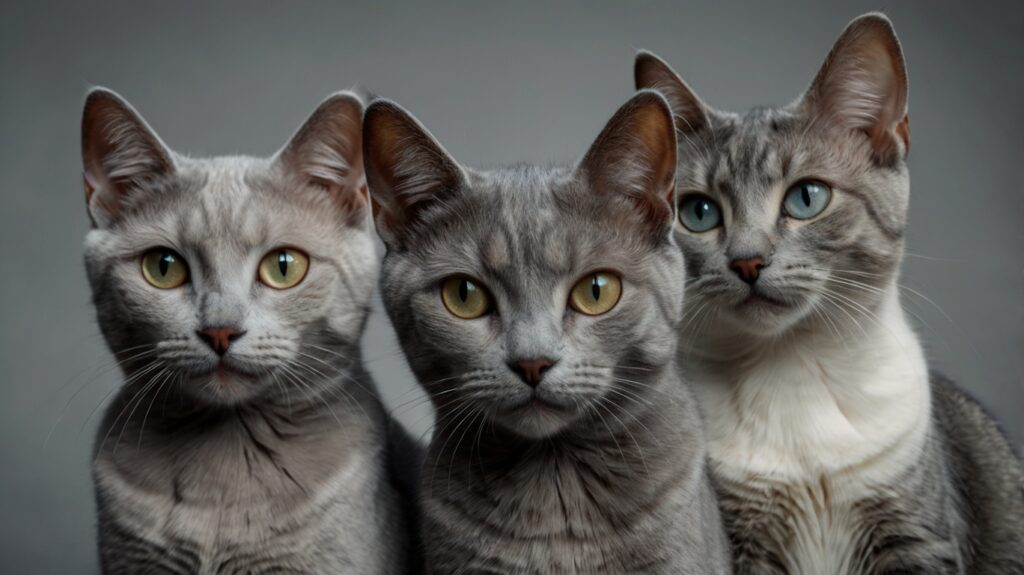Grey Cat Coat Colors: Understanding the Differences Between Grey, Gray, and Bluish-Grey

When it comes to choosing the perfect cat, many people are drawn to those with beautiful grey coats. Whether you’re looking for a fluffy grey cat or a sleek bluish-grey companion, understanding the subtle differences in coat colors can enhance your appreciation of these feline friends. In this article, we will explore the different shades of grey in cats—grey, gray, and bluish-grey—and provide a clear explanation of their origins, characteristics, and how to care for them.
What Do We Mean by “Grey” Cats?
Table of Contents
Before we dive into the differences between grey, gray, and bluish-grey, let’s first understand what “grey” (or “gray”) refers to in a cat’s coat. Grey is a color that spans a variety of shades, from light silver to dark charcoal. It is typically a mixture of black and white hairs or the result of a diluted version of the black gene, which creates the smoky or silver appearance we associate with grey coats.
You may encounter both the terms grey and gray used to describe this color. Grey is the preferred spelling in British English, while gray is used in American English. Both spellings refer to the same color, and there is no difference in the appearance of the cat’s coat—just a difference in spelling preference!
Key Features of Grey Cats
- Coat Colors: Grey cats can have a wide range of shades, from light silvery tones to darker, almost black, hues.
- Breed Examples: Many breeds feature grey coats, including the British Shorthair, Russian Blue, and Chartreux.
- Common Look: Grey cats often have a soft, plush texture to their coats, giving them an elegant appearance.
The Difference Between Grey and Gray Cats
While it might seem like grey and gray are just two ways of spelling the same thing, there is an interesting cultural difference between the two terms.
In the U.S., gray is the preferred spelling for the color, which includes cats with various shades of grey fur. However, in the UK, grey is the standard spelling.
In terms of cat coats, there is no significant difference between a grey and a gray cat in appearance. It’s simply a matter of spelling, with both referring to the same color, which typically appears as a medium tone between black and white.
Bluish-Grey Cats: A More Subtle, Cool Hue
While grey and gray are similar, bluish-grey refers to a distinct, cooler tone of grey. This is not simply a grey coat, but one with a subtle blue undertone. Bluish-grey cats have a soft, misty, and silvery appearance that’s much cooler compared to the neutral or warm tones typically found in grey cats.
Bluish-grey cats are known for their ethereal, almost shimmering look. The color can appear to change depending on lighting conditions, giving them a more unique and stunning appearance. One of the most well-known examples of a bluish-grey cat is the Russian Blue, a breed famous for its sleek, silvery-blue fur.
The Genetic Basis of Bluish-Grey Fur
Bluish-grey coats in cats are primarily caused by a genetic variation in the dilution of the black color gene. Instead of the black pigment appearing dark and rich, it is diluted to a lighter, more silvery-blue tone. This makes bluish-grey cats stand out with their soft, cool-toned coats.
The Genetics of Grey and Bluish-Grey Coats
Understanding the genetic influence behind the grey and bluish-grey colors can help you better appreciate these coats. The genes that control fur color and pattern are passed down from both parents, determining whether your cat will have a grey, gray, or bluish-grey coat. For example, the dilution gene is responsible for producing the soft, cool tones of bluish-grey fur, while other genes may create the more typical grey color.
The Role of the Dilution Gene
The dilution gene can lighten a darker fur color like black or brown, turning it into lighter shades like grey or blue. For instance, a black cat carrying the dilution gene will likely have a bluish-grey coat instead of pure black. This gene is most often seen in Russian Blue cats, Chartreux, and British Shorthairs.
Other Factors Influencing Coat Color
Besides the dilution gene, other genetic factors like the agouti gene can impact the appearance of a cat’s fur, making it look lighter or darker depending on the expression of different coat colors. Understanding these genes can also help explain why some grey cats have a deep charcoal color while others look silver.
Popular Breeds with Grey or Bluish-Grey Coats
Several popular cat breeds have grey or bluish-grey coats, each with its own characteristics and personality traits. Here are some breeds to look out for:
1. Russian Blue
- Coat Color: Bluish-grey with a silvery sheen.
- Personality: Russian Blues are known for being affectionate, quiet, and intelligent. They make excellent companions, especially for people who enjoy a calm, loving cat.
2. British Shorthair
- Coat Color: Thick, plush, and solid grey, often with a round face and large, expressive eyes.
- Personality: These cats are friendly but independent. They tend to be less needy than other breeds, making them great for people who prefer a low-maintenance cat.
3. Chartreux
- Coat Color: Blue-grey with a soft texture.
- Personality: Chartreux cats are playful, affectionate, and highly intelligent. They’re known for their strong bond with their families and are often very gentle.
4. American Shorthair
- Coat Color: Grey tabby or solid grey.
- Personality: These cats are known for being laid-back and adaptable, making them great for families and first-time cat owners.
Caring for Your Grey or Bluish-Grey Cat’s Coat
To keep your grey or bluish-grey cat looking its best, proper grooming and care are essential. Whether you have a short-haired or long-haired cat, taking care of their coat will help maintain its luster and prevent mats or tangles.
1. Brushing Regularly
For cats with longer fur, such as the British Shorthair or Russian Blue, brushing is crucial. Regular brushing prevents tangles and helps remove loose hairs. It also promotes healthy skin by distributing natural oils throughout the coat. Aim for at least once a week, but more often if your cat has longer hair.
2. Bathing (When Necessary)
While cats are great at grooming themselves, they may need the occasional bath to remove dirt or oils that can build up on their fur. Use a cat-safe shampoo and ensure the water is warm, not hot. Be sure to rinse thoroughly to avoid irritation.
3. A Balanced Diet for Healthy Fur
The health of your cat’s fur starts with their diet. Look for food that contains high-quality proteins and omega fatty acids, which promote healthy, shiny fur. Supplements like fish oil or flaxseed can also benefit your cat’s coat and skin.
Why Grey Cats Make Wonderful Pets
Whether you’re interested in a grey fluffy cat or a sleek bluish-grey companion, these cats are more than just beautiful to look at—they have personalities to match. Grey and bluish-grey cats are known for their calm and affectionate nature, making them great companions for families, singles, and older adults alike.
1. Calm and Quiet
Grey and bluish-grey cats tend to be more relaxed than other colors. Their gentle temperament makes them well-suited for a variety of living situations.
2. Affectionate and Loyal
Many grey and bluish-grey cats are known for their strong bond with their human families. They are loyal, loving, and often enjoy sitting in your lap or cuddling with you.
3. Great for First-Time Cat Owners
Because of their laid-back personalities, grey cats can be great for first-time cat owners. They tend to adapt well to new environments and enjoy human company.
Key Takeaways
- Grey and gray refer to the same color, with “gray” being the preferred American spelling and “grey” used in British English.
- Bluish-grey cats have a subtle blue undertone, giving them a cool, misty appearance that makes them unique and striking.
- Breeds like Russian Blue, British Shorthair, and Chartreux are famous for their grey or bluish-grey coats.
- Genetics play a significant role in the coloration of your cat’s coat, with dilution genes responsible for lighter shades.
- Regular grooming and a balanced diet are essential for maintaining the health and appearance of your cat’s coat.
Frequently Asked Questions (FAQ)
What’s the difference between grey and bluish-grey cats?
Grey cats have a neutral or warm tone, while bluish-grey cats have a cool, silvery-blue undertone. Bluish-grey coats often appear lighter and more ethereal.
Can a grey cat be a different color, like tabby or bicolor?
Yes, grey cats can have various coat patterns, including tabby (with stripes or spots) and bicolor (grey with white).
Do I need to bathe my grey or bluish-grey cat?
Generally, cats groom themselves, but if your cat’s coat becomes dirty or oily, a bath may be necessary. Use a mild, cat-safe shampoo.
Are grey cats friendly?
Yes! Many grey and bluish-grey cats are affectionate, calm, and loyal companions.
What breeds typically have grey coats?
Breeds like the Russian Blue, British Shorthair, Chartreux, and American Shorthair are commonly associated with grey coats.
Conclusion: Embrace the Beauty of Grey Cats
Whether you’re captivated by the elegant gray fluffy cat or drawn to the striking beauty of a bluish-grey cat, these felines have much to offer. Their calm, loving nature and stunning coats make them a perfect choice for many cat lovers. With proper care and attention, your grey or bluish-grey cat will bring joy, comfort, and companionship into your life for years to come.
